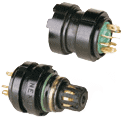What Are Tactile Switches?
Comments Off on What Are Tactile Switches?Tactile switches are electromechanical switches installed beneath the keys of a computer keyboard, motor control keyboard, keypad, and other electronic devices. They produce the satisfying “bump” that users feel in their fingers when they strike a key, coupled with a distinct clicking sound. These tactile and auditory cues inform a user that a key or keyboard is functioning as it should and is registering the applied actuation force during typing. Learn more about the components that make up a tactile switch, why they are useful, and their advantageous characteristics.
Tactile Switch Components
Standard tactile switches have a rather simplistic design structure, generally using only about five key components in their operation. These include:
- Cover. A cover of metal or another rugged material is the external-most component of a tactile switch. It offers protection, shielding the internal components beneath or, if necessary, utilizing a ground terminal to safeguard against detrimental static discharge.
- Plunger. Beneath the cover rests a plunger, which, depending on its application, may be composed of rubber, metal, or another material and have either a raised or flat configuration. The plunger is partly responsible for the tactile and auditory feedback of the switch.
- Contact dome. The contact dome is the other component that, with the plunger, produces the telltale click and feel of a tactile switch. Be it metal or another material, the composition of the plunger and contact dome determine the kind of sound and feel a user will experience. Contact domes have an arched shape that allows these components to reverse their configuration under compression, ultimately creating a circuitry connection between dual contact points fixed in the switch base to power the switch.
- Base. The largest of a tactile switch’s components, a base of molded resin holds the contact points and terminals that enable a connection with a corresponding printed circuit board (PCB) base.
- Actuator. The actuator controls the electromechanics of the tactile switch, allowing it to function. It is responsible for closing and opening the circuit.
Why Choose Tactile Switches?
Tactile switches are a highly reliable and safe mechanical switch option as their operational life typically lasts years. This makes them useful in critical applications that need dependable components, as well as in electronic devices for which constant maintenance would be problematic. They are also easy to use, not requiring much force to activate them, which can help boost typing speed.
If an application has space constraints, tactile switches are ideal as these small devices possess a low profile, making for an optimal fit in notebook computers or other devices with limited internal space. Compared to quiet linear switches or louder clicky switches, tactile switches produce a moderately audible clicking noise and offer a range of tactile feedback based on the plunger and dome material compositions, as well as the switch variant. Their sound is less distracting if volume is a concern in a user’s application.
All of that said, the best tactile switches offer a range of benefits for versatile keyboard and keypad applications from computers and security systems to telephones and appliances.
Benefits of Tactile Switches
These electromechanical switches possess advantageous features that enhance both their reliability and the user experience, including:
- Feedback that users can feel and hear. The sound and feel of a tactile switch are evidence to the user that the switch is operational and engaging with the circuitry. As users are typing, tactile switches help enable them to tell when they have missed a key because they don’t feel or hear the corresponding bump or click.
- Engagement of circuitry. Tactile switches are either on, meaning the electrical current is flowing through them, or they are off. Depending on the switch, the “on” function can be either when a user presses a key or when they release it. This is beneficial because it enables both continuous operation and quick, efficient data input.
- Minimal current and power demands. Tactile switches are capable of functioning while utilizing lower current and power ratings than some other switch types and have less arcing occurring at their points of contact. As a result, this makes them an ideal fit for low-voltage systems and components. They also tend to be more economical to manufacture.
- Longer life span than other varieties. As another factor that impacts their cost-efficiency, tactile switches only contain a small amount of moving components, which means that they often have a longer life cycle than comparable mechanical switch types. Given the reduced maintenance concerns, manufacturers can even mount them directly to a circuit board.
Tactile Switches From Amphenol NEXUS Technologies
Tactile switches are highly versatile given the array of key, material, and actuator options that are available, and Amphenol NEXUS Technologies can assist you in finding the right switch for your application. Our push-button switches offer significant tactile feedback for reliable proof of actuation, and we also offer military-grade components for critical applications. Contact us today to learn more about our product line and how our switches can support your operations.
What Are Waterproof Electrical Connectors?
Comments Off on What Are Waterproof Electrical Connectors?Water from rain, humidity, or snow can easily damage electrical wiring, potentially causing shorts and starting fires. That’s why it’s important to use waterproof electrical connectors to protect the wiring from the elements. Waterproof electrical connectors are designed to keep water out of the connection point, preventing damage and ensuring a safe and reliable connection. Here we’ll discuss how waterproof electrical connectors work as well as their specifications and ratings for various environments.
How Waterproof Connectors Work
Waterproof electrical connectors are a critical component in applications where exposure to water is likely. They are commonly used in marine and outdoor settings, as well as in any indoor environment where high humidity is present. Waterproof electrical connectors form very tight seals to resist even the toughest high-moisture conditions.
This seal is possible through prongs that fit snugly around the connection points. The connectors are often coated with a waterproofing compound like rubber, which enters the receptacle end, fills in any gaps, and provides insulation against electrical shocks. As a result, waterproof electrical connectors provide a reliable and safe way to power equipment in potentially hazardous environments.
Ingress Protection (IP) Ratings
Specified by IEC standard 60529, Ingress Protection (IP) ratings are standards used to rate the level of protection against water, dust, and temperatures that an electrical enclosure offers. The ratings range from no protection to full protection against complete immersion. The higher the IP rating, the greater the protection.
When it comes to waterproof connectors, IP ratings are important to consider because they indicate how well the connector will perform in wet or dusty environments. The first number of an IP rating indicates the protection against solids like dust, while the second number indicates protection against liquids. For example, waterproof connectors are typically rated at IP68, meaning they are completely dust-tight and can withstand being immersed in water for extended periods.
When shopping for waterproof connectors, check the IP code to ensure that the connector will meet your needs. This table provides a detailed look at what each IP number and rating indicates:
| Protection against solids | Protection against liquids | ||
| 0 | No protection | 0 | No protection |
| 1 | Protection against objects larger than 50 mm | 1 | Protection against dripping water |
| 2 | Protection against objects larger than 12 mm | 2 | Protection against dripping water if the enclosure is tilted up by 15° |
| 3 | Protection against objects larger than 2.5 mm | 3 | Protection against spraying water at angles up to 60° |
| 4 | Protection against objects larger than 1 mm | 4 | Protection against splashing water from any direction |
| 5 | Protection against some dust | 5 | Protection against water jetting from a 12.5 mm nozzle in any direction |
| 6 | Protection against all dust | 6 | Limited protection against water immersion up to 1 m in depth |
| 7 | Protection against water immersion up to 1 m in depth for up 30 min | ||
| 8 | Protection against water immersion over 1 m for a time specified by the manufacturer | ||
| 9 | Protection against high-temperature, high-pressure water spraying at close range | ||
Waterproof Electrical Connectors From Amphenol Nexus Technologies
Waterproof electrical connectors are an important part of devices that function in high-moisture areas. If you are in the market for reliable and sturdy connectors, Amphenol Nexus Technologies can help. We offer waterproof plugs and waterproof jacks as part of our product catalog of connectors specifically rated for use in wet environments.
With over 60 years of experience and ISO 9001:2015 certification, we develop products guaranteed to meet even the most exacting performance requirements. Our quality assurance system meets the standards of MIL-Q-9858, MIL-I-45208, MIL-STD-45662, and the sampling standards of MIL-STD-105. Amphenol Nexus Technologies is also on the U.S. Government’s Qualified Products List (QPL) for MIL-C-55116, MIL-C-9177, and MIL-S-8805/3. Contact us or request a quote to learn how we can serve your application.




